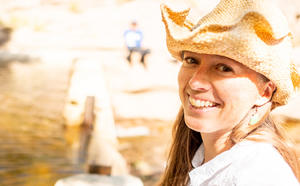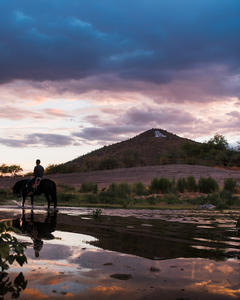The Santa Cruz River now has a steady flow downtown, thanks to Tucson Water’s Santa Cruz River Heritage Project that came on line June 24. The release of recycled water, or treated wastewater, into the Santa Cruz River downtown is a momentous shift for our community; shifting our water infrastructure to support our rivers instead of dewatering our rivers. In the recent past, recycled water discharged in the river was viewed as wasted water, and now it’s being celebrated as an essential resource to support river health and aquifer recharge.
Several years in the making, the Santa Cruz River Heritage Project overcame major policy and management hurdles — thanks to the visionary leadership of Tucson Water and Pima County Regional Flood Control District. Now, and into the indefinite future, the Santa Cruz River has water flowing year-round through the heart of downtown, once again making the river a cultural and environmental amenity to Tucson.
This work is an important building block in Watershed Management Group’s (WMG) 50-year vision and plan to restore Tucson’s heritage of flowing rivers. Having flow in the Santa Cruz River downtown provides a daily visual of what a desert river looks like, which will help open the hearts and minds of the greater community to what is possible.
What is possible in the long-term? Here is WMG’s restoration vision for the Santa Cruz River downtown: The Santa Cruz River flows year-round at the base of Sentinel Peak, supported by a healthy groundwater aquifer. The flowing river is a cultural and ecological gem of our desert community that is essential to our city’s economy and livability. A river walk meanders near the Santa Cruz under a mesquite bosque for people to enjoy the riverside up close, where they can picnic and recreate. The riparian forest is a haven for dozens of bird species and native wildlife is abundant.
The Heritage Project adds up to 2.8 million gallons of recycled water daily (3,150 acre feet a year) to the Santa Cruz River. In addition to providing surface flow, recycled water percolates down through the riverbed to recharge the aquifer.
While recycled water is an important source of surface water flow, a healthy Santa Cruz River will ultimately need to be supported with groundwater, as it was historically. Groundwater connection will ensure the river has flow year-round, that can be supplemented with recycled water but not entirely dependent on recycled water.
Restoring groundwater levels to support surface flow is possible, but will be a much longer-term, comprehensive effort that needs buy-in from the greater community. Groundwater-supported river flow is already taking place; thanks to water recharge efforts by the San Xavier District, the Santa Cruz River is now expressing surface flows near Martinez Hill.
 This bigger vision is starting to build momentum in a collective effort through the Santa Cruz Watershed Collaborative – a 2-year old effort that includes American Rivers, Sonoran Institute, Sky Island Alliance, WMG, Tucson Water, Pima County Regional Flood Control District and many other governmental and nonprofit organizations working together. The collaborative’s mission is to support a resilient and thriving Tucson community that has a healthy watershed supporting flowing streams and rivers.
This bigger vision is starting to build momentum in a collective effort through the Santa Cruz Watershed Collaborative – a 2-year old effort that includes American Rivers, Sonoran Institute, Sky Island Alliance, WMG, Tucson Water, Pima County Regional Flood Control District and many other governmental and nonprofit organizations working together. The collaborative’s mission is to support a resilient and thriving Tucson community that has a healthy watershed supporting flowing streams and rivers.
Our rivers — through collaborative and coordinated actions by agencies, organizations, and residents — can once again rise to the surface, nourish our community, and provide water sustainability into the future.
Join our efforts. Learn about the work WMG is doing with the community through the River Run Network at Watershedmg.org/RRN and come to one of our creek walks, river restoration workshops and clean-ups.
Lisa Shipek is the Executive Director and co-founder of Watershed Management Group and leads community engagement and collaborative governance efforts for their River Run Network program.
A healthy Santa Cruz River ultimately needs to be supported with groundwater

